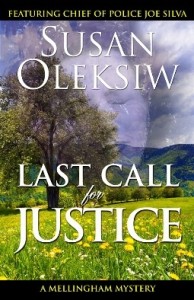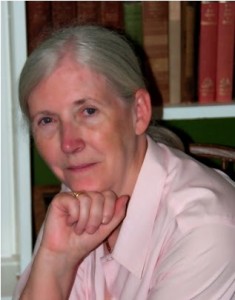Every writer I know has a few tricks to help with editing a mss, and the one I use regularly is the timeline. I write without an outline, and often without any clear sense of where the story is going. Though I often know the ending, I have no idea what’s going to happen along the way. As a result, I tend to contradict myself occasionally about what happened when, and these are the errors I want to catch in a timeline.
In Last Call for Justice: A Mellingham Mystery, Chief Joe Silva attends a family reunion during which events bring to light questions surrounding a supposed accident many years earlier. This is compounded during the family reunion by another assault. Joe is working both forward and backwards in time to solve two crimes.
I set up two timelines when I start working on this editing phase. The first timeline covers the activities of the protagonist in the present, from the opening of the story in chapter one to the end, when the sleuth identifies and confronts or captures the killer. This timeline keeps me from having four chapters take place in one ten-day week, or three fifty-hour days. It forces me to keep time realistic. It also helps me keep track of seasons. If I am using the natural world to set the time for actions, such as spring rains or fall foliage, I want to match seasonal references with the appropriate passage of time. For example, if I mention early fruits in one chapter, and refer to something happening a month later, I can refer to June strawberries in chapter 10 and garden snails and zinnias in July several chapters later.
The format is simple. I draw a horizontal line across a page. Across the top I note the months/years of the action and below I note the action or discovery that I want to track through the story. If I find, for example, that I’ve been unclear or confusing as to when the protagonist first met a witness, I note the contradictory times and pick the one that works best for the story. I note the page references for making the necessary corrections.
The second timeline is for the story the sleuth uncovers. Solving a mystery involves working backwards and putting together puzzle pieces that don’t come in chronological order. I block out the relevant time references for the sleuth’s discoveries until she puts together all the puzzle pieces and sees the entire story of the crime.
A timeline presented as a visual diagram helps me see if I’ve put too much action in too short a space, accidentally put one character in two places at once, or created a scenario impossible for anyone but superman to achieve.
In a short story that will soon appear in Alfred Hitchcock Mystery Magazine, “Francetta Repays Her Debt to Society,” a young woman is confronted with an unwelcoming world in her first days after getting out of prison. I created a vertical timeline for this story, noting each block of half a day, for example, and what she managed to do in that time. I wanted to be confident that she could do all that I had her do.
Writers present their stories in time in different ways. Dashiell Hammett’s story line is linear in The Maltese Falcon, with bits and pieces of the past emerging as the story forges ahead.
In contrast but equally exact in her timing is Kate Atkinson in When Will There Be Good News? I was surprised to realize at the end of the book that the entire story takes place in only three or four days. An enormous amount happens, but it is all timed perfectly. But in this instance, the story emerges like a series of ribbons folded into a giant bow, looping and twisting together.
~~~~~~~~~~~~~~~~~~~~~~~~~
Susan Oleksiw is the author of the Mellingham series featuring Chief of Police Joe Silva (Murder in Mellingham and five other titles are available as eBooks). She also writes the Anita Ray series featuring Indian American photographer Anita Ray, who has appeared in two books, Under the Eye of Kali (2010) and The Wrath of Shiva (2012). Susan compiled A Reader’s Guide to the Classic British Mystery (1988), and was consulting editor for The Oxford Companion to Crime and Mystery Writing (1999). The third installment in the Anita Ray series, For the Love of Parvati, will be published by FiveStar/Gale, Cengage in 2014.
To learn more about Susan and her novels, visit her website and blog.








Susan, Your timing is perfect! I’m at exactly this stage in my WIP and need to figure out what happens exactly when. Like, right now!
Thanks for such a lucid explanation.
Hi Pat and Susan,
Thanks for the helpful information.
I think timelines are an excellent way to keep track when working with a series. Thanks for the suggestion. And I do recommend this novel to readers. It’s a well-written mystery novel with fully developed characters.
Hi, Julie,
I hope it works for you. Thanks for commenting.
Hi, Pat, I’ve stopped writing multiple points of view after switching to a single POV, and it’s so much easier.
Great technique, Susan– thanks for sharing how you do this. Making note and bookmarking. (Waves to Pat)
Hi Susan. I had to map out a detailed timeline for one of my novels because it was multiple point of view with characters in three different states and three different time zones. That was definitely a challenge.
Thanks, Kathleen. If we lived in warmer climes, I could run all the seasons together . . . that might help a little. Thanks for commenting.
Excellent post and one I need.
Like many writers, I need a way to check my work, and timelines are one way. I can easily end up with fifty-hour days if I’m not careful. Thanks for commenting, Alex and Margot.
Pat – Thanks for hosting Susan.
Susan – Thanks for sharing the way you use timelines. I like strategies like that that allow the writer to ‘step back’ and objectively look at how the action in the novel is evolving.
I’ve not used a timeline, but you never know when I might need one. Thanks for the explanation on how to use it, Susan!